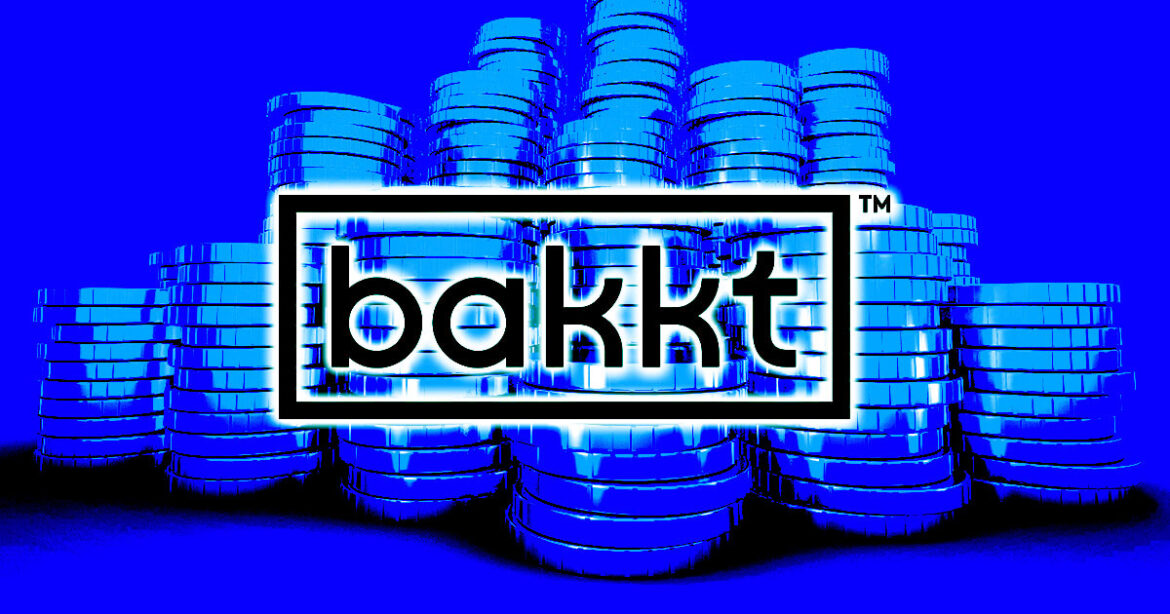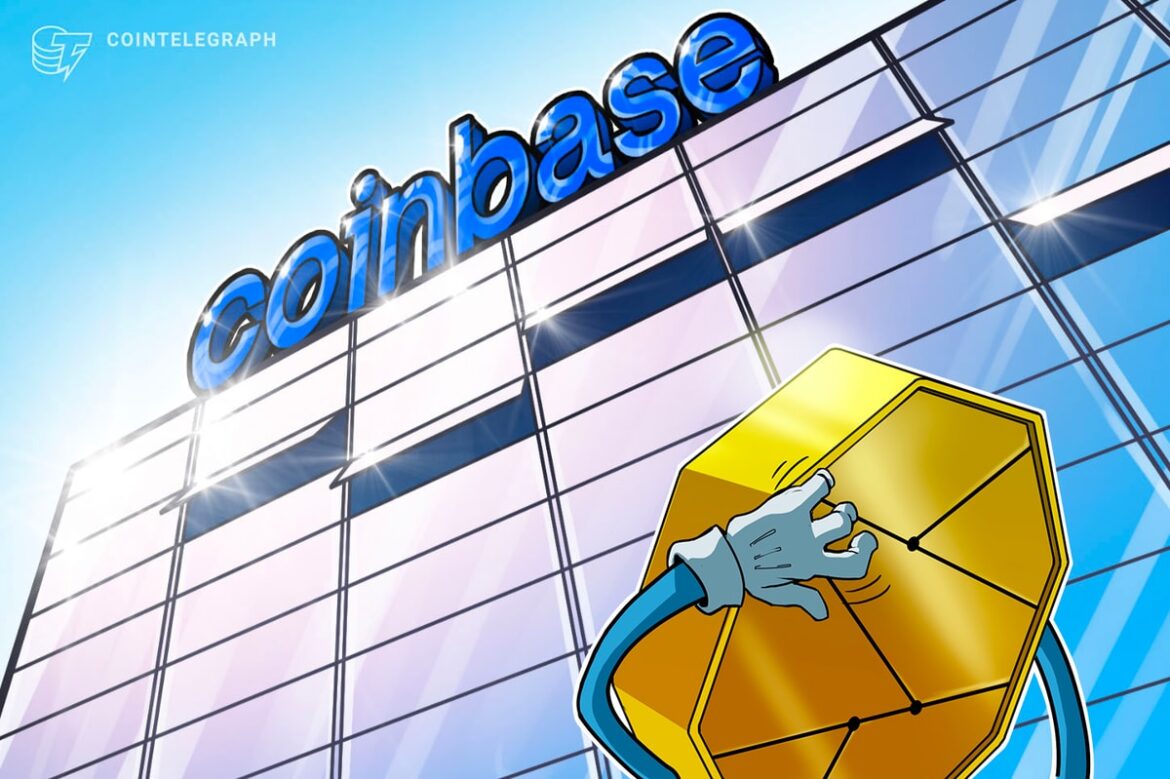 PRESS RELEASE. [Singapore, Mar 22, 2024] Yala, a project that enables the seamless transfer of Bitcoin liquidity through a meta yield stablecoin, is thrilled to announce a comprehensive brand upgrade. This reflects our commitment to making Bitcoin liquidity universally accessible across blockchain ecosystems, enhancing DeFi liquidity efficiency. The upgrade includes a refreshed branding message, a […]
PRESS RELEASE. [Singapore, Mar 22, 2024] Yala, a project that enables the seamless transfer of Bitcoin liquidity through a meta yield stablecoin, is thrilled to announce a comprehensive brand upgrade. This reflects our commitment to making Bitcoin liquidity universally accessible across blockchain ecosystems, enhancing DeFi liquidity efficiency. The upgrade includes a refreshed branding message, a […]
Source link
liquidity
Cosmos DeFi boosted as ‘rivals’ Osmosis and Astroport collaborate on programmable liquidity pools

Cosmos-based decentralized exchange Astroport is set to deploy its passive concentrated liquidity (PCL) pools on Osmosis, the largest Cosmos-based DEX by volume, following successful governance votes on both platforms. This move marks an alignment between two of the most active DEXes in the Cosmos ecosystem, aiming to improve the overall trading experience and capital efficiency for users.
PCL pools, which aim to provide the benefits of concentrated liquidity without requiring active management, will be offered alongside Osmosis’s existing “supercharged liquidity” pools. Astroport’s pools utilize an advanced repegging algorithm that automatically concentrates liquidity around the exponential moving average of ongoing trades. As Astroport core dev Andre Sardo explained,
“With PCL pools, you go and LP in a pool, and you can leave your tokens there for days, months or years, and have it automatically adjust to market conditions. Impermanent loss gets minimized, and fees get maximized.
And because your liquidity is passive, it’s truly programmable or composable. It can be tapped by apps and vaults and aggregators anywhere in the Cosmos.”
The deployment of Astroport’s PCL pools on Osmosis is expected to benefit both protocols. Standard PCL pool fees will flow back to xASTRO stakers, while all trades routed through Astroport’s PCL pools on Osmosis will generate a 0.1% fee for Osmosis, to be split between the Osmosis community pool and the OSMO staking pool. This move is anticipated to expand Astroport’s reach, grow its global trading volume and fee generation, and attract more passive liquidity to Osmosis.
Sunny Aggarwal, Co-Founder of Osmosis Labs, predicted the move could lead to record volumes within the first month.
“Competition is good, but aligning for the benefit of the greater community is even better — so it’s very exciting to see Astroport and Osmosis joining forces here… Only time will tell, but I predict that the Astroport deployment on Osmosis will become one of the biggest by volume within a month or so of the launch.”
While supercharged liquidity and PCL pools may appear to be competitors, the teams believe they are better viewed as complementary offerings catering to different types of LPs. Supercharged liquidity pools are best optimized by professional market makers and active LPs who run their own algorithms and programmatically readjust their liquidity to match market conditions. In contrast, PCL pools cater to more casual LPs who prefer a “deposit and chill” approach, according to the teams, allowing the pool’s algorithm to concentrate their liquidity automatically.
According to Jose Maria Macedo, Founder and CEO of Delphi Labs, this alignment between Astroport and Osmosis is a significant development in the Cosmos ecosystem. Macedo stated,
“It’s two massive DEXes that outsiders look at as rivals coming together and assimilating. And they’re doing it in ways that benefit both protocols. They’re leaning into their strengths and combining to improve liquidity for the entire Cosmos ecosystem.”
Further, Astroport core developer Donovan Solms highlighted the portability of Astroport’s codebase, comparing it to a “magic suitcase” that can be deployed on any Cosmos chain. Solms explained,
“We can go wherever there’s a need for liquidity in the Cosmos. And thanks to IBC, each deployment is interconnected. It’s part of a bigger whole, which is this backend layer of truly passive, truly infinite liquidity.”
Preparations for the deployment are underway, with PCL pools expected to go live on Osmosis in the coming weeks. This historic alignment between Astroport and Osmosis is poised to improve capital efficiency for those who swap or have trades routed through Osmosis while also potentially “defragmenting” liquidity spread across other automated market makers throughout the Cosmos ecosystem.
Mentioned in this article
Latest Alpha Market Report
Bakkt says it is ‘confident’ about continuing operations after disclosing liquidity issues in SEC filing

Bakkt Holdings said in a press release on Feb. 8 that it is “confident” it will continue operating despite expressing concerns earlier over its liquidity in a regulatory filing.
Bakkt wrote that “management remains confident” and intends to continue serving clients and moving toward profitability. The exchange added that its filing with the SEC for the quarter ending September 2023 described various risk factors in part related to its acquisition of Apex Crypto, which concluded in early 2023.
Bakkt said that its Feb. 7 amendment to that filing describes risk factors related to its ability to continue as a going concern for 12 months after the date of the amended form. The company said that its concern analysis can only include management plans that have been implemented or are probable; it must exclude new products and market launches and those without proven revenue.
Bakkt offers business products, including a turnkey crypto trading API, custody services, and crypto reward solutions. Bakkt discontinued an app aimed at retail users in March 2023. Its parent company, ICE, terminated Bakkt Bitcoin futures and options contracts in September 2023.
SEC filing tells a different story
Despite Bakkt’s assurances to the public, its submission to the SEC explicitly states in bold text:
“We might not be able to continue as a going concern.”
According to the filing, Bakkt said that it is not probable that its revenue will generate sufficient profit and cash flows to continue doing business. It also described “expected operating losses and cash burn for the foreseeable future.”
Another section reads:
” … We have determined that we do not believe that our cash and restricted cash are sufficient to fund our operations for the 12 months following the date of this [filing].”
The firm said it is currently seeking additional capital but noted that various methods of raising capital would not be available or acceptable. One option would be to issue securities, but that would dilute its stock value.
Bakkt said that lack of funding may lead it to reduce expansion efforts, cut operating costs, limit future development, or “even terminate operations.” The firm also expressed uncertainty around the handling of crypto in the event of bankruptcy.
The post Bakkt says it is ‘confident’ about continuing operations after disclosing liquidity issues in SEC filing appeared first on CryptoSlate.
Grayscale outflows add further $800 million BTC liquidity to Coinbase Prime OTC desk
Quick Take
According to Arkham Intelligence data, Grayscale transferred another 18,400 BTC to a Coinbase Prime hot wallet on Jan. 17. Sent in several 1,000 BTC transactions, the Bitcoin was valued at around $800 million as of press time.
On Jan. 16, a similar transfer worth $387 million was also conducted by Grayscale, again to Coinbase Prime. The repetitive nature of these hefty transactions suggests possible redemption activity on Grayscale’s part as investors potentially rotate into lower-fee ETFs.
It’s also worth noting that all these transactions were conducted seconds before the U.S. markets opened at 2:30 PM GMT, possibly hinting at a strategy to leverage global market dynamics.
Given the limited supply of Bitcoin and the nature of Coinbase Prime’s role across multiple spot Bitcoin ETFs, the outflows from Grayscale are likely to be used as liquidity for any potential inflows into other Bitcoin ETFs. Only a handful of venues are available to the ETF Trust to purchase Bitcoin, with Coinbase Prime being the leading player.
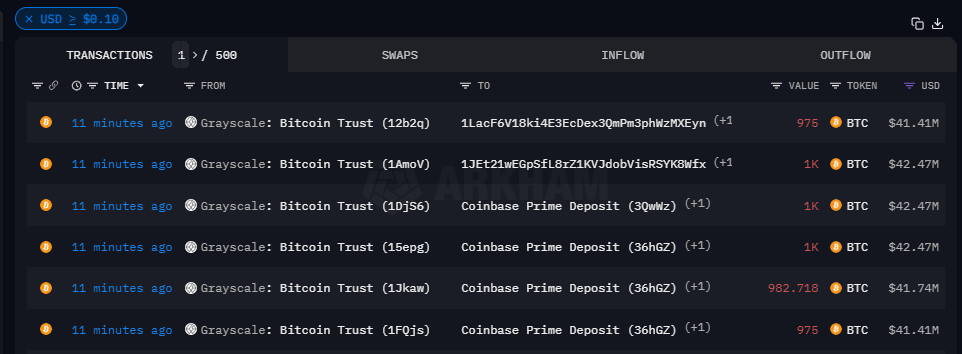
The post Grayscale outflows add further $800 million BTC liquidity to Coinbase Prime OTC desk appeared first on CryptoSlate.
PayPal Incentivizing People To Provide PYUSD Liquidity On Curve, CRV To The Moon?
In a landmark move, PayPal, the payment processor, has incentivized PYUSD liquidity on Curve Finance, the world’s largest stablecoin decentralized exchange (DEX) by trading volume.
PayPal Incentivizing PYUSD Liquidity Via Curve
This development, which Stake DAO first captured on January 10, sent shockwaves through the crypto community, with many experts predicting that Curve is on its way to becoming the go-to platform for institutional and corporate trading of on-chain stablecoins.
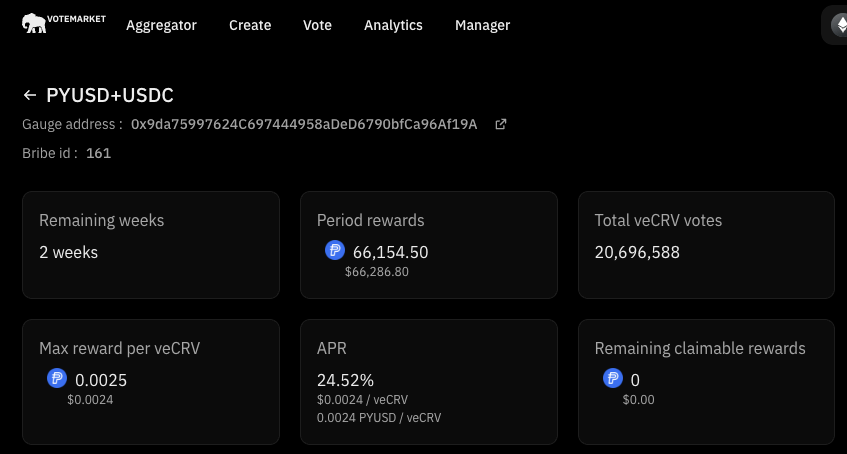
PayPal’s decision to incentivize PYUSD liquidity on Curve is a significant step forward for adopting stablecoins and promoting decentralized finance (DeFi) protocols in general. By providing attractive rewards for liquidity providers, PayPal is signaling its commitment to the growth of this rapidly evolving sector.
As part of its incentive program, PayPal has deposited vote incentives worth $132k in PYUSD on Votemarket, a vote incentive platform. These rewards are designed to encourage users to increase their liquidity on Curve. In addition, PayPal will offer direct rewards to liquidity providers distributed in PYUSD, with an APY of 11%.
Observers note that the $66,000 allocated weekly to Votemarket could direct at least $55k in CRV, a governance token on Curve Finance, to the PYUSD-USDC pool.
Institutional Endorsement: Will CRV Rally Above $0.75?
With PayPal’s endorsement, Curve may attract even more liquidity and cement its position as a leader in on-chain stablecoin trading. It is unclear whether other Wall Street heavyweights on the wings are ready to enhance liquidity via Curve or other DeFi protocols. Their involvement will validate Curve and DeFi’s potential, accelerating adoption among institutional investors.
According to DeFiLlama data on January 10, Curve has a total value locked (TVL) of $1.82 billion, with a big chunk of this in Ethereum. The protocol has deployed in Ethereum layer-2s and other Ethereum Virtual Machine (EVM) compatible platforms, including Arbitrum.
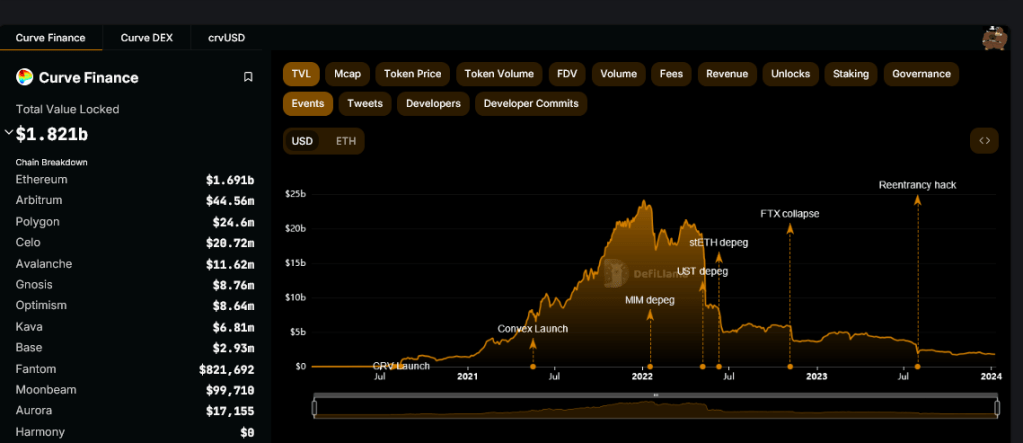
For now, CRV, the native token of Curve, remains under pressure. Looking at the performance in the daily chart, the token is down 30% from recent December peaks, sliding when writing.
From price technical analysis, any break above $0.75 could spark more demand, lifting the token to new 2024 highs. Presently, CRV is trending inside a bear candlestick, signaling general weakness. In the short term, sharp losses below $0.45 might trigger a sell-off. CRV risks dropping to September 2023 lows of around $0.40 in that case.
Feature image from Canva, chart from TradingView
Disclaimer: The article is provided for educational purposes only. It does not represent the opinions of NewsBTC on whether to buy, sell or hold any investments and naturally investing carries risks. You are advised to conduct your own research before making any investment decisions. Use information provided on this website entirely at your own risk.
Bitcoin thrives as China combats deflation with fresh liquidity injections

What is CryptoSlate Alpha?
A web3 membership designed to empower you with cutting-edge insights and knowledge. Learn more ›
Connected to Alpha
Welcome! 👋 You are connected to CryptoSlate Alpha. To manage your wallet connection, click the button below.
Oops…you must lock a minimum of 20,000 ACS
If you don’t have enough, buy ACS on the following exchanges:
Connect via Access Protocol
Access Protocol is a web3 monetization paywall. When users stake ACS, they can access paywalled content. Learn more ›
Disclaimer: By choosing to lock your ACS tokens with CryptoSlate, you accept and recognize that you will be bound by the terms and conditions of your third-party digital wallet provider, as well as any applicable terms and conditions of the Access Foundation. CryptoSlate shall have no responsibility or liability with regard to the provision, access, use, locking, security, integrity, value, or legal status of your ACS Tokens or your digital wallet, including any losses associated with your ACS tokens. It is solely your responsibility to assume the risks associated with locking your ACS tokens with CryptoSlate. For more information, visit our terms page.
Bitcoin (BTC), the world’s leading cryptocurrency, has recently witnessed a surge in price, reaching a new yearly high of $42,100 on Monday. However, this significant price increase has raised concerns among market participants about the possibility of a potential correction and a subsequent liquidation sweep, which could drive the price down to as low as $25,000.
Second Capitulation And Liquidity Sweep For Bitcoin?
Justin Bennett, a prominent technical analysis expert, acknowledges the remarkable performance of Bitcoin, stating, “It’s been a hell of a run from BTC, and it may very well continue without a significant correction in the short term.”
However, Bennett highlights that the previous two bear markets concluded with a second capitulation, suggesting the possibility of a similar scenario occurring this time. Bennet cautions against ruling out a liquidity sweep that could drive the price down to $25,000.
To provide further context, liquidity sweep refers to a sudden and drastic move in price that aims to clear out excess leverage and trigger liquidations of overleveraged positions.
Such a move could lead to a cascading effect, causing the price to drop further as more positions get forcefully closed. The occurrence of a liquidity sweep at the $25,000 level would not only test the resilience of Bitcoin but also serve as a crucial moment for market sentiment.

As seen in the 2-week chart above shared by Bennet, despite the potential correction in BTC, this could be the last difficulty that Bitcoin bulls experience before the continuation of the bull run; this will be further fueled by the potential approval of Bitcoin spot exchange-traded funds (ETFs) applications by the US Securities and Exchange Commission (SEC), which is expected to push prices even higher.
A boost from the halving of Bitcoin will further add to the bullish momentum and sentiment in the market, which could push the price of BTC to new all-time highs (ATH).
Additionally, historical trends indicate a promising outlook for Bitcoin. Analyst Ali Martinez points out that in the past, strong BTC performance during October and November has been followed by a bullish December. According to Martinez, market participants can anticipate a bullish December ahead if this pattern holds.
El Salvador’s BTC Investments Prove Profitable
El Salvador’s President Nayib Bukele recently announced that the nation’s investments in Bitcoin have yielded significant profits, refuting previous claims of losses made by critics.
President Bukele revealed that if El Salvador were to sell its Bitcoin holdings at the current market price, the country would not only fully recover its initial investment but also make a profit of $3,620,277.13.

Addressing the numerous articles and hit pieces that had ridiculed El Salvador’s Bitcoin investment strategy, President Bukele emphasized that these assessments were based on the cryptocurrency’s market price at the time of evaluation. With Bitcoin’s recent surge in value, the country’s investment has turned profitable.
While acknowledging that the price of Bitcoin will continue to fluctuate, President Bukele reaffirmed that El Salvador remains committed to its long-term strategy and has no intention of selling its Bitcoin holdings. President Bukele stated:
Of course, we have no intention of selling; that has never been our objective. We are fully aware that the price will continue to fluctuate in the future, this doesn’t affect our long-term strategy.
At the time of writing, BTC is trading at $41,200, reflecting a notable price increase of 3.8% over the past 24 hours and 12% over the past seven days.
Featured image from Shutterstock, chart from TradingView.com

The European Banking Authority (EBA) — the European Union’s banking watchdog — has proposed a new set of guidelines for stablecoin issuers that will set minimum capital and liquidity requirements.
The new liquidity guidelines aim to ensure the stablecoin can be quickly redeemed even during turbulent market conditions to avoid the risk of bank runs and contagion in a crisis.
Under the proposed liquidity guidelines, stablecoin issuers must offer any stablecoin backed by a currency that is fully redeemable at par to investors. The official proposal by the EBA noted that the stablecoin liquidity guidelines will act as a liquidity stress test for stablecoin issuers.
The EBA believes the stress test will highlight any shortcomings and lack of liquidity for the stablecoin, which can help the authority to only approve fully-backed stablecoins with enough of a liquidity buffer. The guidelines state:
“The liquidity stress testing will help issuers of tokens to better manage their reserve of assets and generally their liquidity risk. Based on the outcome of the liquidity stress testing, the EBA or, where applicable, the relevant competent authority/supervisor, may decide to strengthen the liquidity requirements of the issuer.”
Once approved, the guidelines are set to come into effect from early 2024. After implementing the guidelines, the authorities will have the power to strengthen the liquidity requirements of the relevant issuer to cover those risks based on the outcome of the liquidity stress testing.
Related: Binance plans to delist stablecoins in Europe, citing MiCA compliance
The proposed liquidity rules are aimed at issuers of stablecoins, which can be non-bank institutions, requiring them to meet the same safeguards and avoid unfair capital or liquidity advantages over banks. Currently, the proposal is in the consultation phase, where the general public can give their input. The public consultation phase is open for three months until a public hearing is scheduled on Jan. 30, 2024.
Magazine: ‘AI has killed the industry’: EasyTranslate boss on adapting to change
New growth in top stablecoin supply could signal a return of on-chain liquidity
Quick Take
The recent data analysis illuminates an intriguing trend: a return to growth in the supply of the top five stablecoins – USDT, USDC, BUSD, TUSD, and DAI – after a period of contraction. In the wake of the 2021 bull run, the aggregate supply of these stablecoins skyrocketed from a modest 25 billion to a staggering 162 billion by February 2022. The tide turned, however, and the supply dwindled down, mirroring the downturn of Bitcoin (BTC) in 2022. As of now, the combined supply of the top five stablecoins is approximately 120 billion.
For the first time since April 2022, the supply of these leading stablecoins has begun to swell again, with the inflection point occurring on Oct. 19. Intriguingly, this expansion coincided with a surge in Bitcoin, suggesting a potential return of on-chain liquidity after a protracted bear market. This could provide Bitcoin with a much-needed buoy.
CryptoSlate’s recent observation further corroborates this notion: the influx of stablecoins into Bitcoin was a major catalyst propelling Bitcoin past the $30,000 mark in October. Therefore, tracking this trend of stablecoin supply growth could be vital in forecasting Bitcoin’s market dynamics.
Clearly, USDT constitutes a substantial 70% of the market capitalization of the top five stablecoins, accounting for 85 billion. Recently, CryptoSlate reported on the reducing supply of two of these, BUSD and USDC. However, DAI presents a different story with its circulating supply of 5.3 billion, which appears to have reached its lowest point this year at approximately 4.4 billion. Meanwhile, TUSD has continued to experience a surge, currently standing at a robust 3.3 billion.
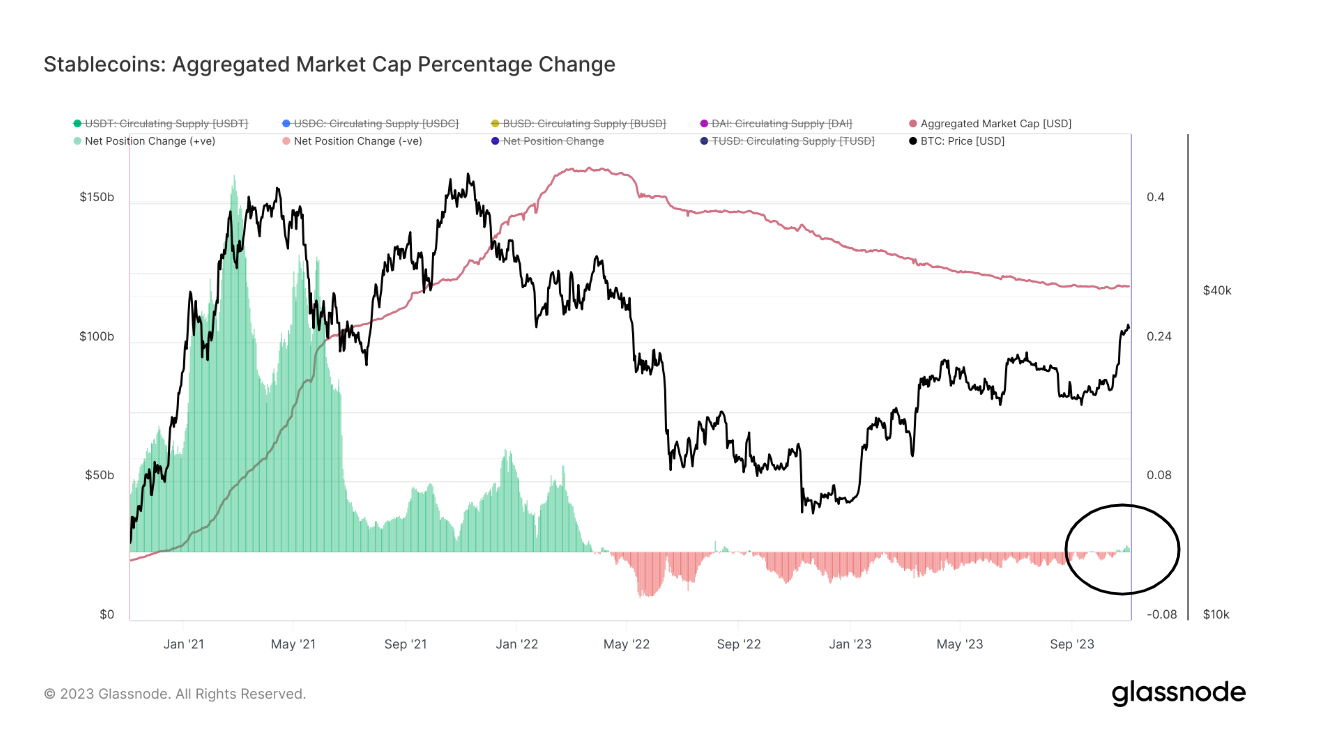
The post New growth in top stablecoin supply could signal a return of on-chain liquidity appeared first on CryptoSlate.
The United States-based cryptocurrency exchange Coinbase is removing dozens of trading pairs in order to improve liquidity on its platform.
Coinbase has suspended 80 non-USD trading pairs, including those with cryptocurrencies like Bitcoin (BTC), stablecoins like Tether (USDT) and fiat currencies like the euro.
Announcing the news on Oct. 16, Coinbase said that the trading pairs’ removals aim to improve “overall market health and consolidate liquidity.” The trading pairs were removed from the Coinbase exchange and other platforms like Advanced Trade and Coinbase Prime at 19:30 UTC on Oct. 16.

The latest trading pairs’ removals on Coinbase align with the exchange’s plans to suspend the markets announced in early October. Coinbase emphasized that users of the affected platforms can still trade the markets in its “more liquid USD order books” by using the exchange’s USD Coin (USDC) balances.
“Please note these markets make up an immaterial amount of Coinbase Exchange’s total trading volume,” the exchange noted.
@CoinbaseExch regularly monitors the markets on our exchange. In an effort to improve overall market health and consolidate liquidity, we will be removing a number of non-USD trading pairs for certain supported assets.
— Coinbase Exchange ️ (@CoinbaseExch) October 2, 2023
Coinbase has been suspending trading pairs on its platforms to improve liquidity for a while. The exchange removed another 41 non-USD markets in mid-September, citing the same reasons. While Coinbase removed multiple USDT-containing trading pairs, none of the suspended markets included USDC, a stablecoin co-developed by Coinbase and Circle.
Related: Securities regulators oppose special treatment of crypto in Coinbase case
Coinbase’s ongoing measures to improve liquidity come amid the exchange’s trading volumes tanking this year. According to the cryptocurrency market data provider CCData, Coinbase’s spot trading volumes for the third quarter plummeted 52% since 2022.
Other major cryptocurrency exchanges like Binance have also seen their spot market share dominance falling this year. According to CCData, Binance’s spot market share fell for a seventh consecutive month in September 2023, tumbling from 55% in early 2023 to 34% in September 2023.
Collect this article as an NFT to preserve this moment in history and show your support for independent journalism in the crypto space.
Magazine: The Truth Behind Cuba’s Bitcoin Revolution: An on-the-ground report



